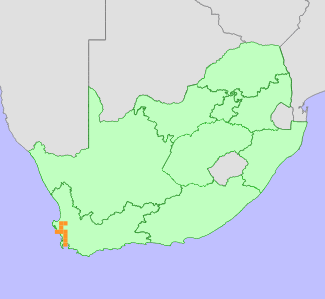|
Scientific Name | Cleretum clavatum (Haw.) Klak |
Higher Classification | Dicotyledons |
Family | AIZOACEAE |
Synonyms | Dorotheanthus clavatus (Haw.) Struck, Dorotheanthus gramineus (Haw.) Schwantes forma albus (Haw.) G.D.Rowley, Dorotheanthus gramineus (Haw.) Schwantes forma roseus (Haw.) G.D.Rowley, Dorotheanthus tricolor (Willd.) L.Bolus, Mesembryanthemum clavatum Haw. |
National Status |
Status and Criteria | Endangered B1ab(ii,iii,iv,v)+2ab(ii,iii,iv,v) |
Assessment Date | 2022/11/11 |
Assessor(s) | C. Klak, D. Raimondo & H. Mtshali |
Justification | A Western Cape endemic that has a restricted distribution range, with an extent of occurrence (EOO) of 2914 km² and an area of occupancy (AOO) of 52 km². The population has been severely fragmented due to 80% habitat loss to crop cultivation and urban expansion; more than 50% of the population occurs as small, isolated subpopulations. The decline is continuing due to alien plant invasions, expanding agriculture, and droughts. It is therefore listed as Endangered under criterion B. |
Distribution |
Endemism | South African endemic |
Provincial distribution | Western Cape |
Range | This species has a restricted distribution in the Western Cape Province, South Africa, where it occurs from Hopefield to the Cape Flats. |
Habitat and Ecology |
Major system | Terrestrial |
Major habitats | Cape Flats Dune Strandveld, Saldanha Flats Strandveld, Swartland Granite Renosterveld, Swartland Alluvium Renosterveld, Cape Flats Sand Fynbos, Atlantis Sand Fynbos, Hopefield Sand Fynbos |
Description | It grows in seasonally wet sands. |
Threats |
| Agriculture is a severe past and present threat to this species. It has lost about 80% of its habitat over the past 70 years to agriculture, mainly to wheat cultivation in the Darling area and potato cultivation in the Velddrif area. All the subpopulations that were on the Cape Flats were lost to urban development. The remaining habitat is declining due to droughts, ongoing agricultural activities, and invasion by alien plants (woody and herbaceous aliens) throughout this species range. |
Population |
This species occurs in isolated, small subpopulations in remnant areas of habitat between crop fields, and therefore the population is considered severely fragmented. In many localities where the species is known through historical records, the habitat has been severely degraded and transformed, and it is likely to be locally extinct in many of these places. A continuing population decline is inferred from ongoing habitat loss and degradation.
|
Population trend | Decreasing |
Assessment History |
Taxon assessed |
Status and Criteria |
Citation/Red List version | | Cleretum clavatum (Haw.) Klak | EN B1ab(i,ii,iii,iv,v) | 2014.1 | | Dorotheanthus clavatus (Haw.) Struck | EN B1ab(i,ii,iii,iv,v) | Raimondo et al. (2009) | |
Bibliography |
Goldblatt, P. and Manning, J.C. 2000. Cape Plants: A conspectus of the Cape Flora of South Africa. Strelitzia 9. National Botanical Institute, Cape Town.
Klak, C. and Bruyns, P.V. 2012. Phylogeny of the Dorotheantheae (Aizoaceae), a tribe of succulent annuals. Taxon 61(2):293-307.
Raimondo, D., von Staden, L., Foden, W., Victor, J.E., Helme, N.A., Turner, R.C., Kamundi, D.A. and Manyama, P.A. 2009. Red List of South African Plants. Strelitzia 25. South African National Biodiversity Institute, Pretoria.
|
Citation |
| Klak, C., Raimondo, D. & Mtshali, H. 2022. Cleretum clavatum (Haw.) Klak. National Assessment: Red List of South African Plants version 2024.1. Accessed on 2025/12/07 |
 Comment on this assessment
Comment on this assessment


